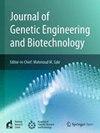Analytical and biological assessment of Magnolia champaca L. stem bark: Integrating ATR-FTIR, GC–MS, thrombolytic activity, brine shrimp lethality and molecular docking
IF 2.8
Q3 Biochemistry, Genetics and Molecular Biology
Journal of Genetic Engineering and Biotechnology
Pub Date : 2025-05-13
DOI:10.1016/j.jgeb.2025.100505
引用次数: 0
Abstract
Cancer and cardiovascular disease are two of the most significant health challenges worldwide. These diseases are responsible for morbidity and mortality, leading to a substantial burden on healthcare systems and economic resources. Numerous innovative therapies have been proposed for combating cancer and cardiovascular disease like thrombosis; however, many of these treatments involve synthetic drugs that may have undesirable side effects. Consequently, the current research aimed to explore the medicinal properties of phytochemicals derived from Magnolia champaca L. This investigation utilized both in vitro and in silico approaches. The identification of phytocompounds were employed by using ATR-FTIR and GC–MS. Thrombolytic activity was assayed using human venous blood and cytotoxicity was assessed through lethality test using nauplii of Artemia salina and finally the molecular docking analysis was performed using a docking software named AutoDock Vina to clearly understand about the interactions of GC–MS identified secondary metabolites with target proteins. The ATR-FTIR spectrum of Magnolia champaca specifies the presence of some alkaloids, polysaccharides, flavonoids as well as glycosidic phytocompounds and GC–MS data identified 23 compounds from crude methanolic extract and among them 2,4-Di-tert-butylphenol; 3-Ethyl-3-hydroxyandrostan-17-one; Hexadecanoic acid, methyl ester; Di-n-octyl phthalate were prominent. The in vitro thrombolytic assay demonstrated that Trans-Syringin and CHF resulted in significant blood clot lysis, achieving 59.39 ± 1.79 % and 45.66 ± 3.63 % respectively comparing 75.75 ± 2.96 % with standard streptokinase. The brine shrimp bioassay indicated moderate to strong toxicological effect. Specifically, Trans-Syringin and the ethyl acetate fraction (EAF) demonstrated considerable cytotoxicity, showing the net values of LC50 were 22.39 µg/ml and 61.78 µg/ml, respectively contrary to 11.45 µg/ml of vincristine sulfate (standard). Molecular docking analysis were conducted to explore the synergistic effects of the compounds identified through GC–MS analysis on tissue plasminogen activator and human topoisomerase-II. The compounds 3-Ethyl-3-hydroxyandrostan-17-one; Cadina-1(10),4-diene and 1,1,7-Trimethyl-4-methylenedecahydro-1H-cyclopropa[e]azulen-7-ol-, (1aR-(1a.alpha.,4a.alpha.,7.beta.,7a.beta.,7b.alpha.))- demonstrated high binding affinities of −7.7, −7.3, and −7.1 kcal/mol, respectively, for tissue plasminogen activator where streptokinase (standard) had −6.5 kcal/mol. For human topoisomerase-II, 3-Ethyl-3-hydroxyandrostan-17-one; Caryophyllene-(I1) and Cadina-1(10),4-diene exhibited binding affinities of −8.0, −7.9 as well as −7.8 kcal/mol correspondingly, while standard vincristine had −8.1 kcal/mol. These findings suggest that Magnolia champaca contains active phytochemicals with significant potentials for diverse pharmacological applications.

厚朴茎皮分析与生物学评价:ATR-FTIR、GC-MS、溶栓活性、盐水对虾致死性及分子对接
癌症和心血管疾病是世界范围内两个最重大的健康挑战。这些疾病造成发病率和死亡率,对卫生保健系统和经济资源造成沉重负担。已经提出了许多创新疗法来对抗癌症和血栓等心血管疾病;然而,许多这些治疗涉及合成药物,可能有不良的副作用。因此,本研究旨在探讨白玉兰植物化学物质的药用特性。本研究采用体外和计算机两种方法。采用ATR-FTIR和GC-MS对其进行鉴定。采用人静液血检测溶栓活性,采用盐叶artemia salina的nauplii进行致死试验评估细胞毒性,最后采用对接软件AutoDock Vina进行分子对接分析,明确GC-MS鉴定的次生代谢物与靶蛋白的相互作用。白玉兰的ATR-FTIR光谱显示其含有部分生物碱、多糖、黄酮类化合物和糖苷类植物化合物,GC-MS从粗甲醇提取物中鉴定出23种化合物,其中2,4-二叔丁基酚;3-Ethyl-3-hydroxyandrostan-17-one;十六烷酸甲酯;邻苯二甲酸二正辛酯居多。体外溶栓实验表明,反式紫丁香素和CHF均能显著溶出血凝块,分别为59.39±1.79%和45.66±3.63%,而标准链激酶溶栓率为75.75±2.96%。盐水对虾生物试验表明,其毒理作用为中强毒理作用。其中,反式丁香苷和乙酸乙酯部分(EAF)表现出相当大的细胞毒性,LC50的净值分别为22.39µg/ml和61.78µg/ml,而硫酸长春新碱(标准)的LC50为11.45µg/ml。进行分子对接分析,探讨通过GC-MS分析鉴定的化合物对组织纤溶酶原激活剂和人拓扑异构酶ii的协同作用。化合物3-乙基-3-羟基雄烷-17- 1;cadna -1(10,4 -二烯和1,1,7-三甲基-4-亚甲基十氢- 1h -环丙[e]azulen-7-ol-, (1aR-(1a. α,4a. α,7. β,7a. β,7b. α))))-对组织型纤溶酶原激活剂的结合亲和力分别为- 7.7,- 7.3和- 7.1 kcal/mol,而链激酶(标准)的结合亲和力为- 6.5 kcal/mol。对于人拓扑异构酶ii, 3-乙基-3-羟基雄烷-17- 1;石竹烯-(1)和Cadina-1(10),4-二烯的结合亲和力分别为−8.0、−7.9和−7.8 kcal/mol,而标准长春新碱的结合亲和力为−8.1 kcal/mol。这些发现表明,厚朴含有活性植物化学物质,具有重要的药理应用潜力。
本文章由计算机程序翻译,如有差异,请以英文原文为准。
求助全文
约1分钟内获得全文
求助全文
来源期刊

Journal of Genetic Engineering and Biotechnology
Biochemistry, Genetics and Molecular Biology-Biotechnology
CiteScore
5.70
自引率
5.70%
发文量
159
审稿时长
16 weeks
期刊介绍:
Journal of genetic engineering and biotechnology is devoted to rapid publication of full-length research papers that leads to significant contribution in advancing knowledge in genetic engineering and biotechnology and provide novel perspectives in this research area. JGEB includes all major themes related to genetic engineering and recombinant DNA. The area of interest of JGEB includes but not restricted to: •Plant genetics •Animal genetics •Bacterial enzymes •Agricultural Biotechnology, •Biochemistry, •Biophysics, •Bioinformatics, •Environmental Biotechnology, •Industrial Biotechnology, •Microbial biotechnology, •Medical Biotechnology, •Bioenergy, Biosafety, •Biosecurity, •Bioethics, •GMOS, •Genomic, •Proteomic JGEB accepts
 求助内容:
求助内容: 应助结果提醒方式:
应助结果提醒方式:


